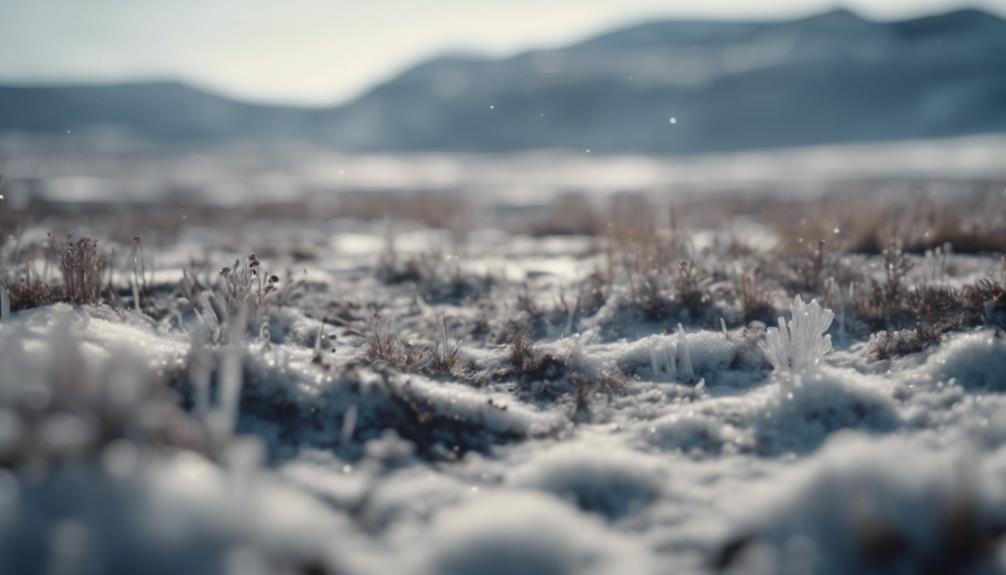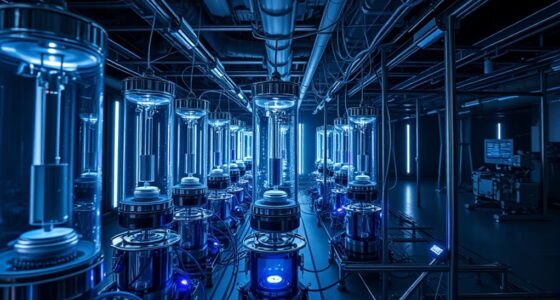As the Arctic tundra warms, soil microbes are expected to increase their CO2 production, intensifying concerns about escalating climate change due to higher greenhouse gas emissions. The rise in temperatures triggers a significant rise in microbial activity, leading to more CO2 release. This heightened CO2 production by soil microbes underscores the urgent need to address the potential acceleration of global warming through increased emissions. Further information on this topic could shed light on the intricate relationship between Arctic tundra warming, microbial activity, and CO2 production.
Key Takeaways
- Rising temperatures in Arctic tundra increase soil microbe CO2 production.
- Increased microbial activity accelerates CO2 release with warming.
- Soil microbes play a crucial role in CO2 dynamics as tundra warms.
- Even slight temperature rises trigger significant CO2 production by microbes.
- Understanding and monitoring soil microbes are vital for predicting CO2 changes.
Arctic Tundra Warming and CO2 Production
Arctic tundra warming accelerates CO2 production by underground microbes. As temperatures rise in the Arctic, soil microbes become more active, leading to increased CO2 production through respiration processes. This heightened microbial activity is a direct result of the warming climate in tundra regions.
The permafrost in the Arctic stores an immense amount of carbon, approximately 1,700 billion metric tons. However, with the degradation of permafrost projected by 2100, there's a looming concern of releasing 22-524 billion metric tons of carbon into the atmosphere. This potential release poses a threat as it could turn the tundra from a carbon sink into a significant carbon source.
Studies have shown that even a relatively small temperature increase of 1.4°C can cause a substantial 30% rise in CO2 respiration by soil microbes, indicating the sensitivity of the Arctic ecosystem to climate change. The variability in CO2 release across different tundra sites emphasizes the complex interplay between warming temperatures and microbial activities in the region.
Impacts of Soil Microbes in Tundra
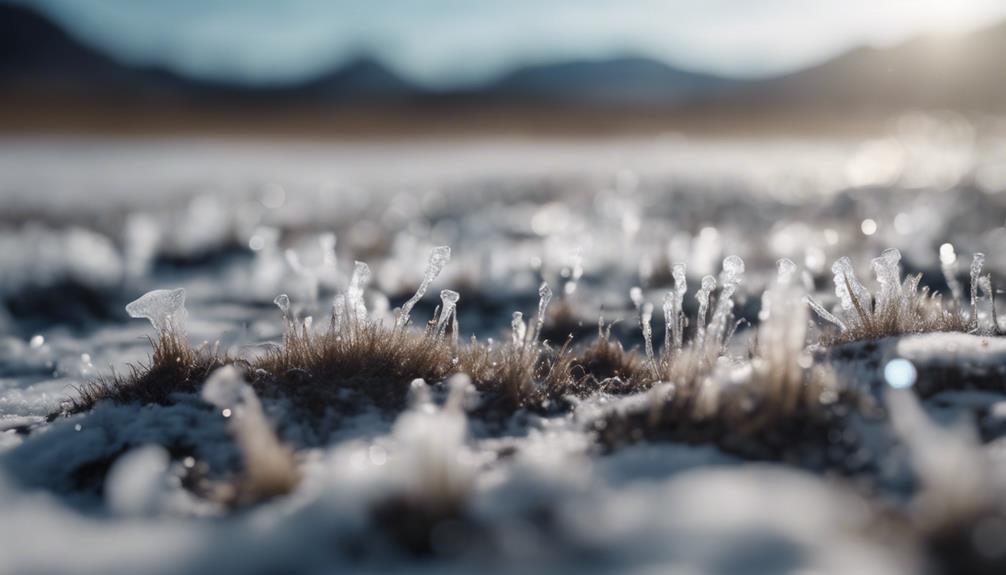
Analyzing the impacts of soil microbes in tundra reveals significant insights into the ecosystem's response to rising temperatures. In the Arctic tundra, soil microbes play a pivotal role in CO2 production. As temperatures increase, these microbes become more active, leading to a higher release of CO2 into the atmosphere.
This heightened microbial activity creates a feedback loop in which rising temperatures stimulate more CO2 production, exacerbating global warming. The Arctic tundra's soil stores a vast amount of carbon, approximately 1,700 billion metric tons, making it essential to understand how soil microbes influence CO2 release.
Variability in CO2 emissions across different tundra regions further emphasizes the complex interactions between soil microbes and climate change. By comprehending the impacts of soil microbes on CO2 production, scientists can better predict how the tundra will respond to increasing temperatures, aiding in our understanding of the broader implications of climate change on this delicate ecosystem.
Rising Temperatures and Microbial Activity
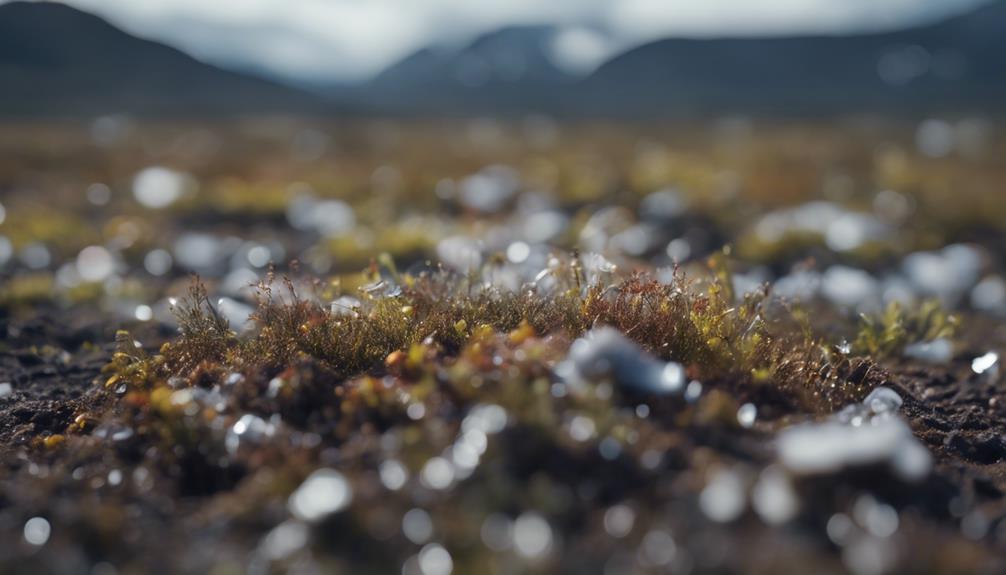
The relationship between rising temperatures and microbial activity in the Arctic tundra underscores the significant impact of climate change on CO2 production. As temperatures continue to increase in the Arctic region, soil microbes are becoming more active, leading to a rise in CO2 emissions. This has critical implications for the delicate balance of greenhouse gases in the atmosphere and the overall climate system. To better understand this complex interaction, scientists have made several key observations:
- Increased Microbial CO2 Production: Studies have shown that even a slight temperature rise can trigger a 30% increase in CO2 respiration by soil microbes. This heightened microbial activity could have substantial consequences for the global carbon cycle.
- Nitrogen-Poor Soil Response: Microbes residing in nitrogen-poor soil exhibit a more pronounced release of CO2 in response to warming temperatures. This highlights the interconnectedness of soil nutrient levels and microbial CO2 production in the Arctic tundra.
- Long-Term Uncertainty: While immediate effects are observable, the long-term impacts of enhanced microbial activity on CO2 emissions in Arctic tundra ecosystems remain uncertain. Further research is essential for predicting future climate scenarios accurately.
CO2 Release in Tundra Ecosystems
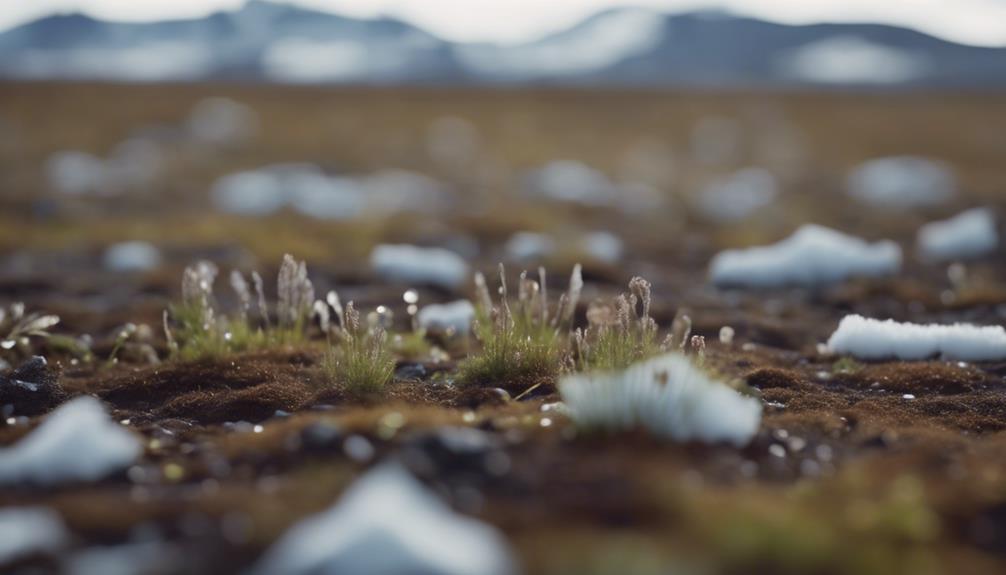
Rising temperatures in Arctic tundra ecosystems trigger a 30% increase in CO2 respiration by plants and microbes, impacting the delicate balance of carbon exchange.
Soil composition, particularly nitrogen levels, serves as a critical determinant in the release of carbon dioxide in these regions.
As studies suggest, while initial warming may prompt higher CO2 release by soil microbes, a potential decrease in carbon emission over time could alter the tundra's role as a carbon sink or source.
Impact on Permafrost
As temperatures increase in the Arctic tundra, soil microbes ramp up CO2 production, potentially leading to significant impacts on permafrost. The degradation of permafrost due to rising temperatures in the Arctic can have important consequences on the balance of carbon storage. This could trigger a feedback loop where the release of carbon stored in permafrost further exacerbates climate change. Understanding this delicate balance is essential for predicting the future of tundra ecosystems.
- Permafrost degradation in the Arctic tundra could result in the release of a substantial amount of carbon, ranging from 22 to 524 billion metric tons by 2100.
- The vast carbon storage in Arctic permafrost, estimated at around 1,700 billion metric tons, underscores the potential impact of its degradation on the global carbon cycle.
- The heightened CO2 production by soil microbes in response to warming temperatures may significantly contribute to the release of greenhouse gases, amplifying the effects of climate change in tundra regions.
Microbial Activity Increase
With increasing temperatures in the Arctic tundra, underground soil microbes are stepping up their CO2 production. Studies conducted across 28 tundra regions have revealed a 30% increase in CO2 respiration with just a 1.4°C rise in temperature.
The variability in CO2 release among different tundra sites underscores the intricate responses within these ecosystems. The vast Arctic permafrost currently holds around 1,700 billion metric tons of carbon, raising concerns about potential releases ranging from 22 to 524 billion metric tons by the year 2100.
The understanding of microbial CO2 emissions is important for predicting whether these tundras will shift from carbon sinks to sources in a warming climate. The significant role of soil microbes in the CO2 cycle highlights the importance of monitoring and comprehending microbial activity in the Arctic tundra to grasp the full extent of its impact on global carbon dynamics.
Climate Change Implications
The amplified CO2 production by underground soil microbes in the Arctic tundra due to increasing temperatures raises concerns about the ecosystem's impact on global carbon dynamics. As temperatures rise in the tundra, soil microbes become more active, leading to a higher release of CO2 into the atmosphere. This phenomenon has significant implications for climate change, as the Arctic permafrost, holding vast amounts of carbon, may start releasing it as CO2 with the ongoing warming.
Here are three key points to consider regarding the climate change implications of CO2 release in tundra ecosystems:
- The transition of tundra ecosystems from carbon sinks to sources of CO2 intensifies the greenhouse effect, contributing to global warming.
- The variability in CO2 release across different tundra sites underscores the complexity of how climate change affects soil microbes and carbon dynamics.
- Accurate predictions about the CO2 production in tundra regions are crucial for understanding and mitigating the impact of climate change on Arctic ecosystems.
Microbial Response to Climate Change

Increased CO2 production by underground microbes in the Arctic tundra is triggered by warming temperatures. Recent research conducted in 28 tundra regions has revealed a direct correlation between rising temperatures and increased microbial activity, leading to higher CO2 emissions from the soil. This phenomenon is particularly pronounced in nitrogen-poor soil under warmer conditions. The long-term implications of this microbial response to climate change are concerning, as it remains uncertain whether tundra areas will act as carbon sources or sinks in the future.
Of significant importance is the estimation by NASA that Arctic permafrost currently stores around 1,700 billion metric tons of carbon. This underscores the critical role that microbial CO2 emissions play in the delicate carbon storage balance of the region. As temperatures continue to rise in the Arctic due to climate change, understanding and monitoring the response of soil microbes becomes increasingly crucial in predicting the overall impact on carbon dynamics in these vulnerable ecosystems.
Greenhouse Gas Effect in Tundra
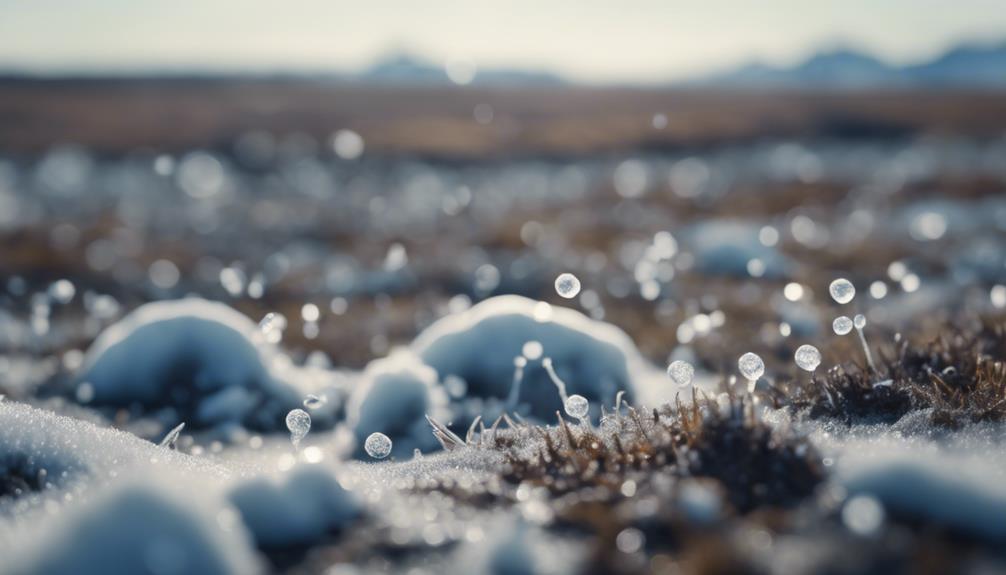
Experiencing rising temperatures, the Arctic tundra exhibits a notable increase in CO2 production by underground microbes. This rise in temperatures triggers a chain reaction within the delicate ecosystem, where soil microbes become more active, accelerating the decomposition process and releasing more CO2 into the atmosphere.
This surge in CO2 production contributes to the greenhouse gas effect, intensifying global warming and further fueling climate change. The implications of this heightened CO2 release are significant, as it not only impacts the delicate balance of the Arctic tundra but also has far-reaching environmental consequences.
The Arctic tundra, known for its vast carbon storage in permafrost, now faces the risk of releasing massive amounts of carbon emissions due to these escalating microbial activities. This creates a concerning feedback loop where increased temperatures lead to more CO2 production, exacerbating the environmental impact and highlighting the urgency of understanding and addressing the complex dynamics at play in the Arctic tundra.
Balancing Carbon Storage in Tundra
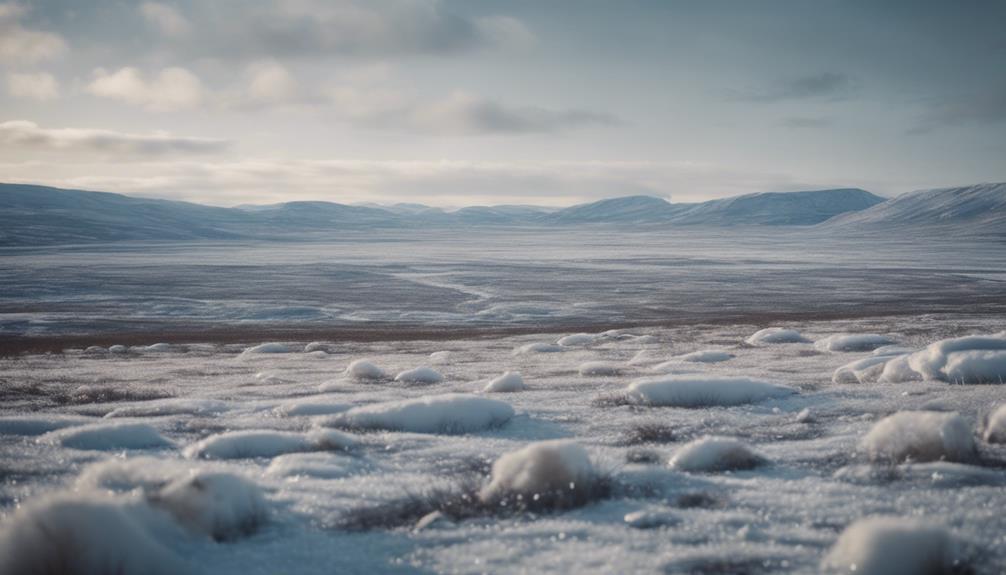
Balancing carbon storage in the Arctic tundra requires a keen understanding of how rising temperatures impact soil microbial activity and the delicate equilibrium between carbon absorption and release. Soil microbes are pivotal in tundra ecosystems as they participate in the carbon cycling process. The balance between carbon storage and emissions is vital to prevent the release of excessive CO2 into the atmosphere. Rising temperatures can disrupt this balance, influencing the intricate dynamics of carbon in the environment. By comprehending the environmental impact of soil microbes and their CO2 production, scientists can better predict and manage the carbon dynamics in the Arctic tundra.
| Key Points | Details |
|---|---|
| Importance of Soil Microbes | Soil microbes play a critical role in the carbon cycling process in tundra ecosystems. |
| Carbon Storage | Maintaining a balance between carbon storage and emissions is essential to prevent CO2 release. |
| Rising Temperatures Impact | Rising temperatures can disrupt the equilibrium between carbon absorption and release. |
| Environmental Impact | Understanding soil microbial activity is key to predicting and managing carbon dynamics in the Arctic tundra. |
Monitoring Soil Microbes in Warming Tundra

Monitoring soil microbes in the warming Arctic tundra reveals a notable increase in CO2 production. This rise in CO2 release is primarily driven by the heightened microbial activity triggered by rising temperatures. Studies conducted in 28 tundra regions spanning the Arctic and alpine zones have consistently shown this trend. To comprehend the implications of this surge in CO2 production, monitoring soil microbes becomes essential.
- Impact on Carbon Emissions: The intensified CO2 production by soil microbes in warming tundra regions contributes markedly to carbon emissions, potentially accelerating climate change.
- Ecosystem Shifts: The long-term effects of increased CO2 release may lead to transformations in tundra ecosystems, potentially shifting them from carbon sinks to carbon sources.
- Importance of Monitoring: Understanding the responses of soil microbes to warming temperatures is vital for predicting and managing the changes that climate change may impose on the delicate Arctic tundra ecosystem.
Predicting Climate Change Implications
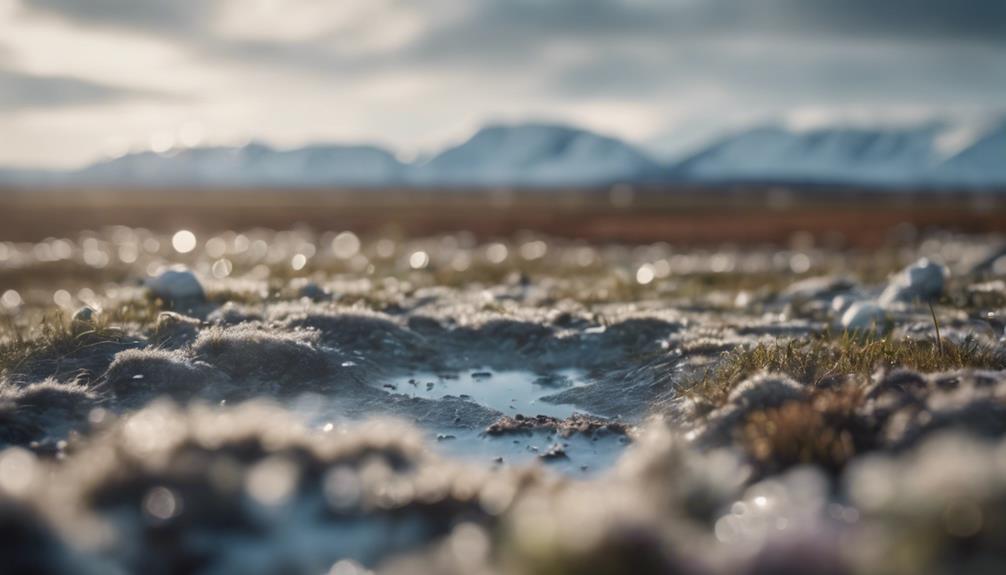
Climate change implications are vital to take into account in the context of Arctic tundra warming.
As temperatures rise, soil microbes respond by increasing CO2 production, potentially leading to significant impacts on greenhouse gas levels.
Understanding how these interactions influence CO2 release is essential for predicting the broader consequences of climate change on the fragile Arctic ecosystem.
Climate Change Impacts
With rising temperatures in the Arctic tundra, soil microbes are expected to increase CO2 production substantially. This rise in temperature triggers a chain reaction where soil microbes become more active, leading to a higher release of CO2 into the atmosphere. This process contributes to the acceleration of climate change and has significant environmental impacts globally.
To understand the significance of this situation, here are three important points to take into account:
- The Arctic tundra's delicate balance is disrupted as rising temperatures stimulate soil microbes, amplifying CO2 production levels.
- Research indicates a 30% increase in CO2 respiration with just a 1.4°C temperature rise, highlighting the sensitivity of this ecosystem to climate variations.
- The variability in CO2 release observed across different tundra field sites underscores the complexity of predicting the exact impact of soil microbes on carbon release.
Soil Microbes Response
As Arctic tundra temperatures rise, soil microbes are positioned to greatly enhance CO2 production, impacting climate change dynamics. With the Arctic permafrost storing a massive 1,700 billion metric tons of carbon, the potential consequences of this microbial response are significant. Studies have already shown a 30% increase in CO2 respiration with just a 1.4°C temperature rise in some regions, indicating the sensitivity of soil microbes to changing environmental conditions.
This variability in CO2 release across different tundra areas suggests that the impact of rising temperatures on CO2 production may not be uniform throughout the Arctic. Long-term implications include the concerning possibility of tundras shifting from being carbon sinks to carbon sources, which could have far-reaching consequences for global carbon balances.
Understanding the role of soil microbes in CO2 production is critical for predicting the environmental impacts of climate change and developing strategies to mitigate its effects on carbon storage in the Arctic tundra.
Co2 Production Increase
Amidst rising temperatures in the Arctic tundra, soil microbes are expected to greatly increase their production of carbon dioxide (CO2). This escalation in CO2 production by soil microbes is a concerning aspect of climate change implications in the region.
Here are three key points to ponder:
- The Arctic permafrost contains a vast amount of carbon, approximately 1,700 billion metric tons. As the tundra warms, soil microbes become more active, potentially releasing significant amounts of CO2 into the atmosphere.
- Studies conducted across 28 tundra regions have demonstrated a clear link between rising temperatures and heightened CO2 respiration by soil microbes. This correlation underscores the urgency of understanding and monitoring these microbial activities in the face of climate change.
- Future projections indicate that the degradation of Arctic permafrost could lead to the release of between 22-524 billion metric tons of carbon by 2100. Such releases would have a substantial impact on global carbon emissions, highlighting the critical need to address the implications of increasing CO2 production in the Arctic tundra.
Understanding Tundra Carbon Dynamics
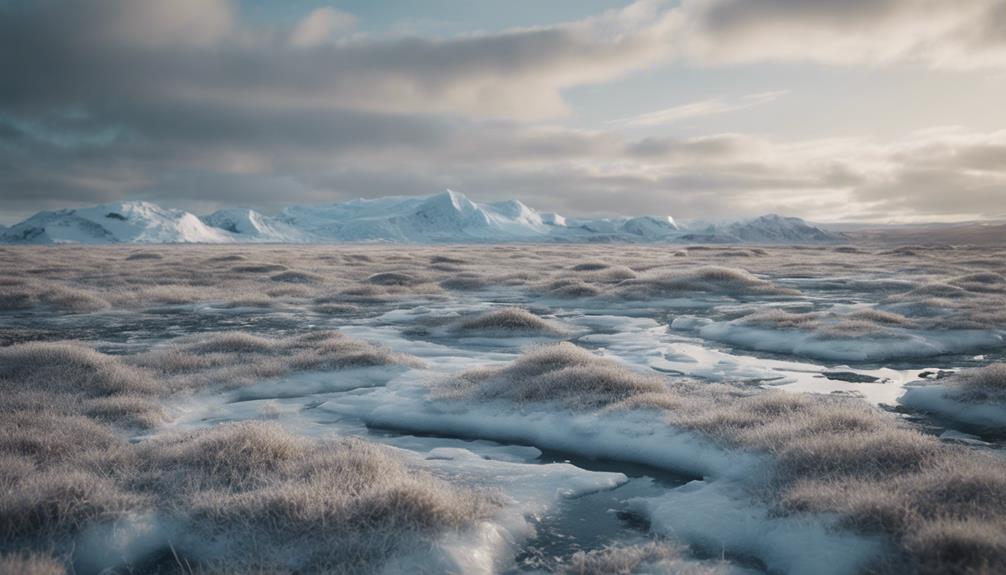
In the domain of understanding tundra carbon dynamics, the intricate interplay between soil microbes and rising temperatures is a critical focal point for researchers. As the Arctic tundra warms, environmental scientists are particularly concerned about the impact on carbon dynamics.
The relationship between warming temperatures and CO2 production by soil microbes creates a concerning feedback loop within these delicate ecosystems. Studies have shown a 30% increase in CO2 respiration with just a 1.4°C temperature rise, highlighting the sensitivity of tundra regions to environmental changes.
However, it's essential to note that the variability in CO2 release across different tundra areas complicates predictions about the long-term effects of soil warming on microbial CO2 production. The uncertainty surrounding the shift of tundra ecosystems from carbon sinks to carbon sources underscores the complexity of this issue.
Further research is needed to fully grasp the consequences of warming on tundra carbon dynamics and the potential implications for global carbon cycles.
Research on Soil Microbes and CO2

Researchers investigating soil microbes in the Arctic tundra are uncovering insights into their role in CO2 production as temperatures rise. Studies conducted in various tundra regions across the Arctic have shown a notable correlation between increasing temperatures and heightened microbial CO2 release.
The following points shed light on the current research on soil microbes and CO2 production in the Arctic tundra:
- Climate Change Impact: Rising temperatures in the Arctic are triggering increased microbial activity in tundra soils, potentially leading to a surge in CO2 emissions.
- Carbon Balance Implications: Understanding the dynamics of soil microbes and their CO2 production is essential for predicting and managing the carbon balance in the tundra ecosystem as it undergoes significant environmental shifts.
- Complex Interactions: Variability in CO2 release among different tundra sites underscores the intricate interplay of factors influencing microbial activity, highlighting the need for thorough research to grasp the full extent of these interactions in the face of climate change challenges.
Importance of Studying Arctic Tundra

Studying the Arctic tundra is essential for understanding its rapid warming and the implications for CO2 production by soil microbes. As warming temperatures affect the Arctic tundra at a rate four times faster than the global average, the role of soil microbes in CO2 production becomes increasingly significant.
With even a modest 1.4°C temperature rise potentially leading to a 30% increase in CO2 respiration, the impact on carbon emissions is substantial. The vast stores of carbon in the Arctic permafrost, estimated at 1,700 billion metric tons, further emphasize the urgency of studying soil microbes in this region.
Research on 28 tundra regions has highlighted the variability in CO2 release, underscoring the tundra's potential to shift from a carbon sink to a carbon source. Understanding the interplay between warming temperatures, soil microbes, and CO2 production is essential for predicting the Arctic tundra's future role in climate change and global carbon emissions, making this area of study pivotal in environmental science.
Addressing CO2 Increase in Tundra
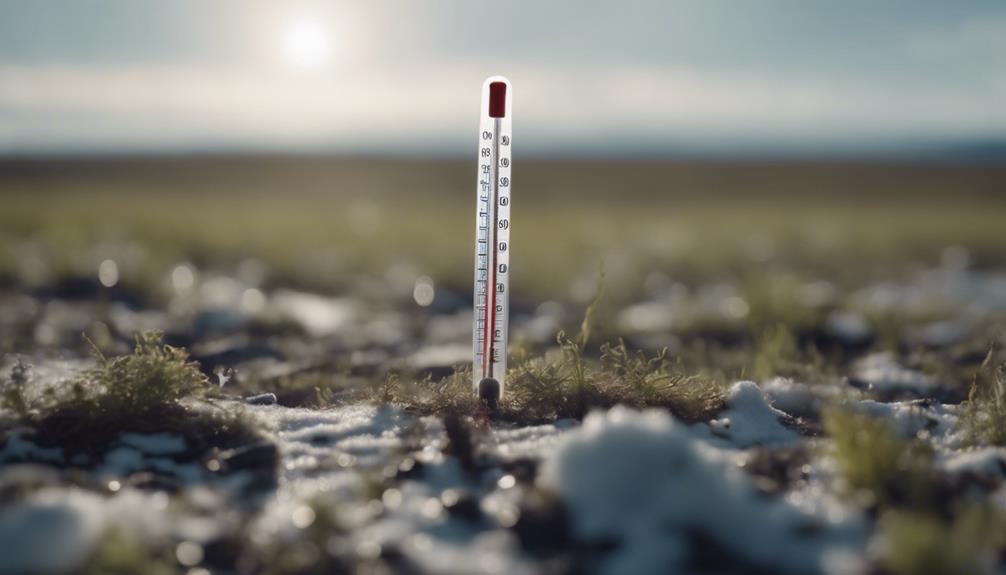
Addressing the CO2 increase in the tundra requires a thorough understanding of the interplay between soil microbes, warming temperatures, and carbon emissions. To effectively tackle this issue, researchers and policymakers must consider the following:
- Climate change impacts:
With the Arctic tundra warming rapidly, the delicate balance of soil microbes and CO2 production is being disrupted. Understanding the implications of this change is important for developing effective mitigation strategies.
- Soil microbial activity:
The role of soil microbes in CO2 production can't be underestimated. Their increased respiration due to warming temperatures can greatly contribute to carbon emissions, exacerbating climate change.
- Adapting to warming:
As temperatures rise, the tundra ecosystem may experience shifts in photosynthetic activity of plants. Monitoring these changes is essential to assess the ecosystem's capacity to offset the CO2 released by soil microbes.
Implications of Microbial Activity

Increased microbial activity in the Arctic tundra due to rising temperatures is poised to have a significant impact on carbon dioxide emissions. As temperatures rise, soil microbes become more active, leading to increased CO2 production through ecosystem respiration. This heightened microbial activity in the tundra plays an important role in the carbon cycle and has significant implications for climate change. The Arctic permafrost, which holds a vast amount of carbon storage, is particularly vulnerable to temperature increases, potentially releasing substantial amounts of CO2 into the atmosphere.
Studies have already demonstrated a 30% rise in CO2 respiration with a mere 1.4°C temperature increase in tundra regions, underlining the sensitivity of these ecosystems to warming. The variability in CO2 release observed across different tundra sites highlights the complexity of microbial responses to temperature changes. Understanding these implications is crucial for accurately predicting how the tundra will respond to ongoing climate change and the subsequent impacts on global CO2 levels.
Long-Term Effects of Warming on Tundra
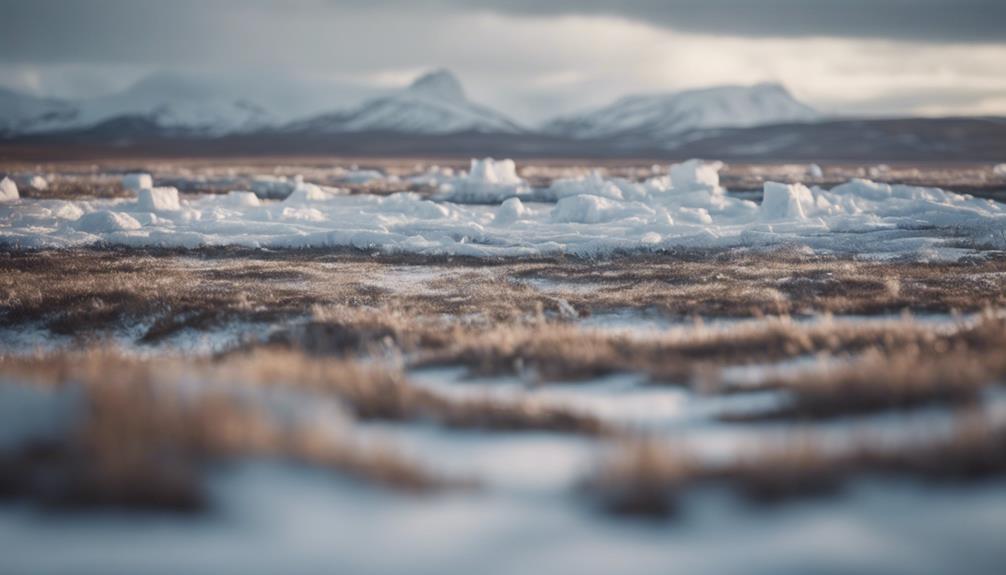
The evolution of Arctic tundra ecosystems under prolonged warming remains a topic of uncertainty and critical importance for climate researchers. Soil warming experiments have revealed intriguing insights into the long-term effects of warming on tundra ecosystems:
- Initial carbon release: Soil warming experiments in the Arctic tundra demonstrated an initial surge in carbon release by soil microbes. This phenomenon raised concerns about the potential acceleration of climate change due to increased carbon emissions.
- Long-term adaptation: Surprisingly, after 18 years of continuous soil warming, microbial communities in the tundra exhibited a decreased carbon release compared to the early stages of the experiment. This adaptation highlights the complexity of ecosystem responses to prolonged warming and the need for further research to understand these dynamics.
- Carbon balance implications: The delicate balance between carbon absorption and release in tundra ecosystems is vital for mitigating climate change. Factors beyond plant and microbe respiration, influenced by soil warming, will play a significant role in determining the overall carbon balance in the warming Arctic tundra.
Frequently Asked Questions
How Does the Carbon Cycle Work in the Arctic Tundra?
In the Arctic tundra, the carbon cycle involves a delicate balance between carbon storage and release. As temperatures rise, soil microbes become more active, increasing CO2 production. This heightened microbial respiration releases stored carbon into the atmosphere.
Understanding these processes is essential for predicting the tundra's response to climate change accurately. The Arctic's vast carbon reservoir in its permafrost underscores the significance of comprehending the carbon cycle dynamics in this region.
How Does the Arctic Tundra Contribute to Global Warming?
As the Arctic tundra warms, it contributes to global warming by accelerating CO2 production through soil microbes. With rising temperatures, these microbes increase CO2 respiration, potentially releasing vast amounts of stored carbon into the atmosphere.
This shift may transform tundra ecosystems from carbon sinks to carbon sources, intensifying the greenhouse effect. Understanding the nuanced response of tundra soil microbes is essential for predicting and mitigating future carbon emissions.
Does the Tundra Consume Carbon Dioxide?
Soil microbes in the Arctic tundra don't consume carbon dioxide; rather, they contribute to its release. As the tundra warms, these microbes are expected to increase CO2 production.
Studies show that even a modest 1.4°C rise can lead to a significant 30% uptick in CO2 respiration by these organisms.
The Arctic's vast permafrost holds immense carbon stores, with potential releases of billions of metric tons due to warming, underscoring the critical role of soil microbes in CO2 dynamics.
Why Will Arctic Soils Release More CO2 Into the Atmosphere as Earth's Temperatures Continue to Rise?
Arctic soils will release more CO2 into the atmosphere as Earth's temperatures rise due to the response of underground microbes to warming conditions. This increased CO2 production is projected to occur as a result of heightened microbial activity in the soil, leading to a rise in CO2 respiration.
The complex nature of soil microbe behavior across different tundra sites underscores the variability in CO2 release, necessitating enhanced data collection and nuanced analysis for accurate predictions regarding Arctic soil responses to climate change.
Conclusion
In summary, as the Arctic tundra warms, soil microbes are expected to increase CO2 production, contributing to climate change.
One interesting statistic to note is that soil microbes in the Arctic tundra currently store approximately 15-30% of global soil carbon.
Understanding the impacts of rising temperatures on microbial activity is vital for addressing CO2 release in tundra ecosystems and mitigating long-term effects of warming on this sensitive environment.
